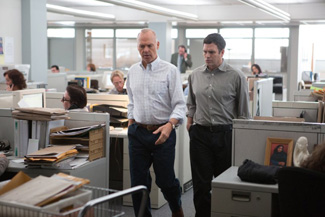They Shoot Oscar Prognosticators, Don't They?
TIFF Part 2: Room Wins at TIFF, Set for Best Pic Nod
By J. Don Birnam
September 21, 2015
Ixcanul and A Foreign Oscar Race for the Ages
A true revelation for me this TIFF has been the Guatemalan submission to the Best Foreign Language Film race, Ixcanul (which, in Maya, means volcano). Shot almost entirely in the K’iche dialect of the Mayan language, the movie was made on a nickel and shot almost entirely near an active volcano. It tells the story of a Mayan family working on a plantation and the difficulties they face as they try to marry their daughter off. I will not give more of the plot away of this entrancing, beautiful poem to celebrate indigenous heritage while pointing out the myriad injustices they suffer in their society today - from corruption at the hands of police to inability to communicate because of poor education - other than to say that it is subtly emotional and tender, at the same time that it is unforgiving in forcing viewers to interact with the subject matter.
Perhaps even more fascinating was the explanation the director gave after the screening - that his inspiration was in part his mother, who at a young age went to work to help such indigenous communities; that he found the Maya-speaking actors basically on the street (they were a roving band of amateur actors); and that he filmed it almost entirely without electricity near the live volcano.
I do not know if Guatemala will make it to the final five this year - Hungary, Brazil, Taiwan, Norway and France all have strong contenders. But I will be surprised and disappointed if it does not make it into the bakeoff round of nine, and highly recommend it in any event.
The Rest so Far
Another welcome surprise was James White, by the producer of Marcy May Marlene, starring a stunning Cynthia Nixon and the revelation of Christopher Abbott (of Girls fame). The story is billed as the struggle of one young man to deal with his excessive behaviors in the face of deep familial changes. It is more accurately described, by spoiling something that is revealed within the first quarter of the movie, as the story of this man as he deals with having to take care of his terminally ill mother. The story is emotionally profound, devastatingly real, and unforgivingly sentimental. The cinematography is a character too - focused almost exclusively on close-ups of the title character, who frankly gives a riveting performance in what had to have been excruciatingly difficult working conditions. Indeed, in a Q&A after the movie, Abbott described the claustrophobia of such extended close-ups, while Nixon praised the agility with which the camera team pulled it off without truly disturbing the actors.
It shows, because the scenes of close, raw emotions are hard to conceive us as staged in front of a camera. One may quarrel a bit with the disjointed narrative of the film’s two or maybe three acts - it never seems to be both about White’s substance abuse and his mother’s illness (the two intersect at times and obviously live in the same plane, but only tangentially collide and transition from one to the other).
The movie picked up distribution at Sundance in January and will be released in November in the United States. Given its difficult subject matter, I do not expect it to figure in the awards race, but it is a powerful and honest examination of grief, loss, and addiction, and worth the price of admission.
Less interesting was the Chilean The Club, helmed by the Oscar nominated director of the Chilean No. The movie centers on a group of old priests banished to a house of penance in the Chilean coast, for a variety of crimes from the obvious pedophilia, to corruption, and stealing babies. The symbolism and artistry of the movie are profound and admirable at times - the no-frills scenery and shots, together with hyper-real acting and moving performances, make you feel as if you’re truly watching real-life people. The problem is it is not clear why we should care to watch them - some of the scenes are unnecessarily disturbing or uncomfortable, and the narrative arc fails to fall into a coherent point or message.
Finally, it is also a strong year for documentaries at the Oscars, it seems, with many already being thrown around as contenders. One that will not be in the conversation is Women He’s Undressed, by Gillian Armstrong, the acclaimed director of Little Women. Made as a sort of paean to Australia itself, it tells the story of famed but today-less known costume designer Orry-Kelly. The narrative style is clunky and even cartoonish, leaving the movie square out of contention, but the subject matter is fascinating to all film buffs.
Kelly was an openly gay men who was rumored to have had a love affair with Cary Grant. He dressed leading women from Greta Garbo to Bette Davis to Katherine Hepburn all the way through to Natalie Wood and Jane Fonda. He designed costumes as far ranging as Some Like it Hot, Gypsy, and Casablanca. He won three Academy Awards. Through interviews of other costume designers and leading ladies like Angela Lansbury, the film tells of a fascinating life in a time long gone by, but it will go no further than to tickle the fancies of movie dorks like me.
Continued:
1
2
3
|
|
|
|




